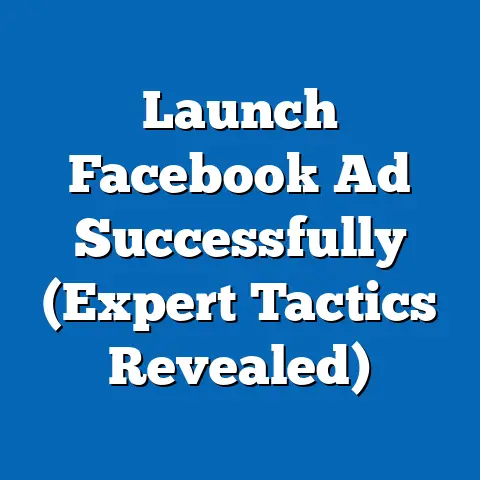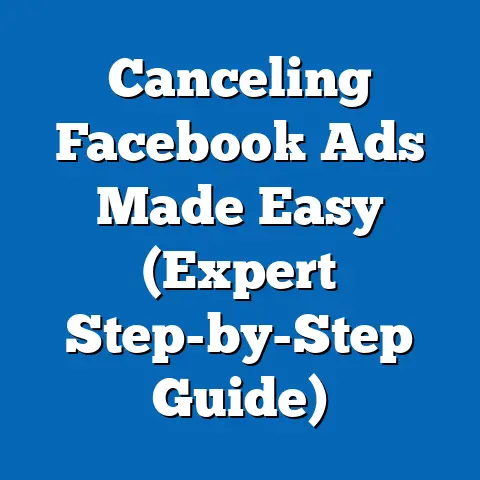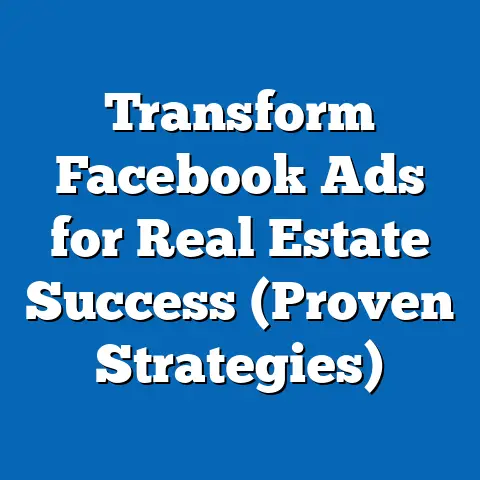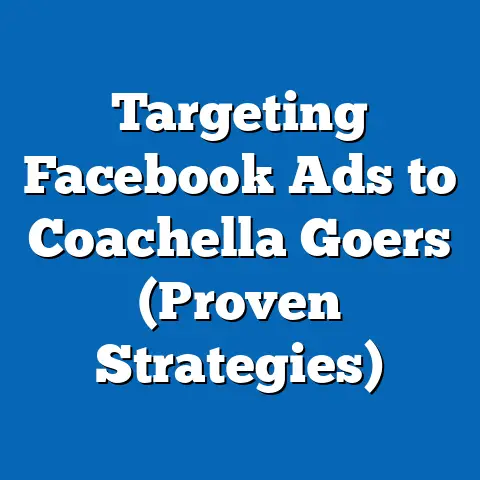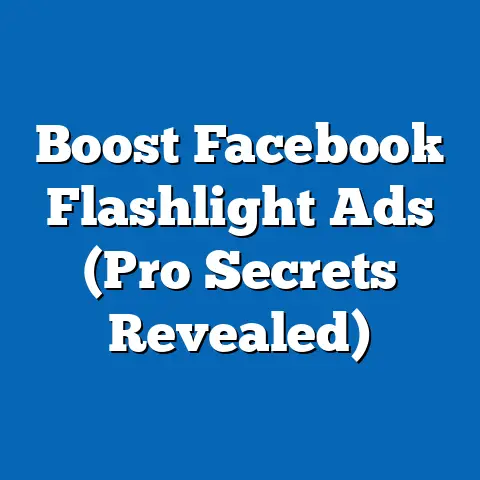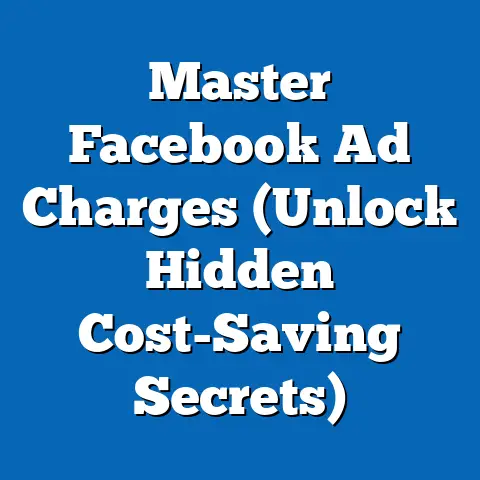Set the Right Facebook Ad Pricing (Cost-Effective Strategies)
Have you ever felt like throwing money into a black hole when running Facebook ads? I know I have! It’s a common frustration: pouring your hard-earned marketing budget into the platform, only to see meager results. The truth is, Facebook advertising can be incredibly powerful, but only if you get the pricing right. The platform is a competitive landscape, and without a strategic approach to budgeting and pricing, businesses often fall into two traps: overspending with a negligible return on investment or underspending and missing out on golden opportunities.
I’ve personally seen both scenarios play out. I remember working with a local bakery that was eager to boost its online presence. They started with a massive daily budget, thinking it would guarantee success. Instead, they burned through their funds in a week, targeting everyone and no one, and achieving almost no sales. On the other hand, I had a client who was so afraid of wasting money that they set a ridiculously low budget. Their ads were rarely shown, and they never gained any traction.
The key takeaway? Finding the sweet spot for ad pricing can dramatically impact your overall campaign performance, engagement, and conversion rates. It’s not just about the numbers; it’s about understanding the platform, your audience, and your goals. In this article, I’ll walk you through several cost-effective strategies to help you optimize your Facebook ad pricing and unlock the true potential of your advertising efforts. Let’s dive in!
Understanding Facebook Ad Pricing Models
Facebook’s ad pricing isn’t a one-size-fits-all scenario. It’s a dynamic system with various models designed to cater to different campaign objectives. Choosing the right model is the first step towards cost-effective advertising. Let’s break down the most common ones:
-
Cost Per Click (CPC): This is probably the most well-known model. You pay each time someone clicks on your ad. It’s great for driving traffic to your website or landing page. I’ve found CPC to be particularly effective for campaigns focused on direct response, where the primary goal is to get people to take immediate action.
-
Cost Per Impression (CPM): With CPM, you pay for every 1,000 times your ad is shown, regardless of whether people click on it. CPM is often used for brand awareness campaigns, where the goal is to get your brand in front of as many eyes as possible. I remember working on a campaign for a new clothing brand, and CPM was our go-to strategy. We weren’t necessarily looking for immediate sales; we wanted to build brand recognition first.
-
Cost Per Action (CPA): This model allows you to pay only when someone takes a specific action, such as liking your page, downloading an app, or submitting a form. CPA can be a more cost-effective option if you have a clear conversion goal in mind. I’ve used CPA successfully for lead generation campaigns, where the goal is to collect contact information from potential customers.
-
Cost Per Conversion: This pricing model focuses on only charging you when a user completes a specific conversion action, such as making a purchase or signing up for a service. It’s the most results-oriented model, but it typically requires a well-optimized funnel and a compelling offer.
Cost Per Click (CPC): This is probably the most well-known model. You pay each time someone clicks on your ad. It’s great for driving traffic to your website or landing page. I’ve found CPC to be particularly effective for campaigns focused on direct response, where the primary goal is to get people to take immediate action.
Cost Per Impression (CPM): With CPM, you pay for every 1,000 times your ad is shown, regardless of whether people click on it. CPM is often used for brand awareness campaigns, where the goal is to get your brand in front of as many eyes as possible. I remember working on a campaign for a new clothing brand, and CPM was our go-to strategy. We weren’t necessarily looking for immediate sales; we wanted to build brand recognition first.
Cost Per Action (CPA): This model allows you to pay only when someone takes a specific action, such as liking your page, downloading an app, or submitting a form. CPA can be a more cost-effective option if you have a clear conversion goal in mind. I’ve used CPA successfully for lead generation campaigns, where the goal is to collect contact information from potential customers.
Cost Per Conversion: This pricing model focuses on only charging you when a user completes a specific conversion action, such as making a purchase or signing up for a service. It’s the most results-oriented model, but it typically requires a well-optimized funnel and a compelling offer.
Real-World Examples and Insights:
I once worked with an e-commerce store that was struggling to generate sales through Facebook ads. They were using CPM, thinking that brand awareness would eventually lead to conversions. However, after switching to CPC and optimizing their ad copy and landing pages, they saw a significant increase in sales. This highlights the importance of aligning your pricing model with your specific objectives.
Another example comes from a non-profit organization I consulted with. They were running a campaign to raise awareness about their cause. They initially used CPC, but found that it was too expensive. After switching to CPM, they were able to reach a much larger audience at a lower cost, effectively spreading their message.
Key Takeaway: The pricing model you choose should directly reflect your campaign goals. If you’re focused on driving traffic, CPC might be the best option. If you’re focused on brand awareness, CPM could be more effective. And if you’re focused on conversions, CPA is worth exploring.
Next Steps: Take some time to analyze your campaign objectives. What are you trying to achieve? Once you have a clear understanding of your goals, you can choose the pricing model that’s most likely to help you achieve them.
Setting a Budget and Bidding Strategy
Once you’ve chosen your pricing model, the next step is setting a budget and bidding strategy. This is where things can get tricky, but with a little planning and analysis, you can create a budget that works for you.
Budgeting Tips:
-
Daily vs. Lifetime Budgets: Facebook allows you to set either a daily budget or a lifetime budget. A daily budget is the average amount you’re willing to spend each day. A lifetime budget is the total amount you’re willing to spend over the entire duration of your campaign. I typically recommend starting with a daily budget, as it gives you more flexibility to make adjustments based on performance.
-
Realistic Expectations: It’s important to set realistic expectations based on industry benchmarks. Don’t expect to generate thousands of leads with a $10 daily budget. Research the average cost per click or cost per conversion in your industry to get a sense of what’s achievable.
-
Start Small, Scale Up: I always advise clients to start with a small budget and gradually scale up as they see results. This allows you to test different ad variations and targeting options without risking a large amount of money.
Daily vs. Lifetime Budgets: Facebook allows you to set either a daily budget or a lifetime budget. A daily budget is the average amount you’re willing to spend each day. A lifetime budget is the total amount you’re willing to spend over the entire duration of your campaign. I typically recommend starting with a daily budget, as it gives you more flexibility to make adjustments based on performance.
Realistic Expectations: It’s important to set realistic expectations based on industry benchmarks. Don’t expect to generate thousands of leads with a $10 daily budget. Research the average cost per click or cost per conversion in your industry to get a sense of what’s achievable.
Start Small, Scale Up: I always advise clients to start with a small budget and gradually scale up as they see results. This allows you to test different ad variations and targeting options without risking a large amount of money.
Bidding Strategies:
-
Manual Bidding: With manual bidding, you set the maximum amount you’re willing to pay for each click or impression. This gives you more control over your ad spend, but it also requires more monitoring and adjustments. I often use manual bidding when I have a specific target cost per click or cost per conversion in mind.
-
Automatic Bidding: Facebook’s automatic bidding algorithm automatically adjusts your bids to get you the best results within your budget. This is a good option if you’re new to Facebook advertising or if you don’t have the time to manually adjust your bids.
Manual Bidding: With manual bidding, you set the maximum amount you’re willing to pay for each click or impression. This gives you more control over your ad spend, but it also requires more monitoring and adjustments. I often use manual bidding when I have a specific target cost per click or cost per conversion in mind.
Automatic Bidding: Facebook’s automatic bidding algorithm automatically adjusts your bids to get you the best results within your budget. This is a good option if you’re new to Facebook advertising or if you don’t have the time to manually adjust your bids.
Audience Targeting and Budget Effectiveness:
One of the biggest factors influencing budget effectiveness is your audience targeting. The more specific and relevant your targeting, the more likely you are to reach people who are interested in your product or service. This can lead to higher engagement rates and lower costs per conversion.
I remember working on a campaign for a local gym. Initially, they were targeting everyone in a 20-mile radius. After refining their targeting to focus on people who were interested in fitness, health, and wellness, they saw a significant increase in leads and a decrease in their cost per lead.
Key Takeaway: Setting a budget and bidding strategy requires careful planning and analysis. Start small, set realistic expectations, and refine your targeting to maximize the effectiveness of your ad spend.
Next Steps: Calculate a sample budget using the industry benchmarks and average conversion rates related to your niche. Then, set up your first campaign with a small budget and watch your results.
Target Audience and Market Research
Understanding your target audience is paramount to setting effective ad pricing. Think of it this way: you wouldn’t try to sell snow to Eskimos, right? Similarly, without knowing who you’re trying to reach, your ad spend will likely be wasted.
Why Target Audience Matters:
-
Increased Relevance: When you target the right audience, your ads become more relevant, leading to higher engagement rates and lower costs per click or impression.
-
Improved Conversion Rates: Reaching people who are genuinely interested in your product or service increases the likelihood of them converting into customers.
-
Reduced Ad Waste: By focusing your ad spend on the right audience, you avoid wasting money on people who are unlikely to be interested in what you have to offer.
Increased Relevance: When you target the right audience, your ads become more relevant, leading to higher engagement rates and lower costs per click or impression.
Improved Conversion Rates: Reaching people who are genuinely interested in your product or service increases the likelihood of them converting into customers.
Reduced Ad Waste: By focusing your ad spend on the right audience, you avoid wasting money on people who are unlikely to be interested in what you have to offer.
Tools and Methods for Market Research:
-
Facebook Audience Insights: This is a powerful tool that provides valuable insights into the demographics, interests, and behaviors of your target audience. You can use it to learn about their age, gender, location, education level, interests, and even their purchasing habits.
-
Customer Surveys: Conducting surveys can provide valuable qualitative data about your target audience. Ask them about their needs, pain points, and preferences.
-
Social Media Listening: Monitor social media conversations to see what people are saying about your industry, your competitors, and your brand. This can provide valuable insights into their needs and preferences.
-
Competitor Analysis: Analyze your competitors’ marketing efforts to see who they’re targeting and what strategies they’re using. This can give you ideas for your own targeting and pricing strategies.
Facebook Audience Insights: This is a powerful tool that provides valuable insights into the demographics, interests, and behaviors of your target audience. You can use it to learn about their age, gender, location, education level, interests, and even their purchasing habits.
Customer Surveys: Conducting surveys can provide valuable qualitative data about your target audience. Ask them about their needs, pain points, and preferences.
Social Media Listening: Monitor social media conversations to see what people are saying about your industry, your competitors, and your brand. This can provide valuable insights into their needs and preferences.
Competitor Analysis: Analyze your competitors’ marketing efforts to see who they’re targeting and what strategies they’re using. This can give you ideas for your own targeting and pricing strategies.
Real-World Example:
I once worked with a software company that was launching a new project management tool. They initially targeted a broad audience of business professionals. However, after conducting market research, they discovered that their tool was particularly appealing to small business owners and freelancers. By refining their targeting to focus on this specific audience, they saw a significant increase in sign-ups and a decrease in their cost per sign-up.
Key Takeaway: Market research is essential for understanding your target audience and setting effective ad pricing. Use tools like Facebook Audience Insights to gather data about their demographics, interests, and behaviors.
Next Steps: Conduct market research using Facebook Audience Insights or other tools to learn more about your target audience. Use this data to refine your ad targeting and pricing strategies.
A/B Testing and Optimization
A/B testing, also known as split testing, is the process of comparing two versions of an ad to see which one performs better. It’s a crucial tool for finding the most cost-effective pricing for your Facebook ads.
The A/B Testing Process:
-
Identify Elements to Test: Choose specific elements of your ad to test, such as the image, headline, body copy, call to action, or audience segment.
-
Create Variations: Create two versions of your ad, each with a different variation of the element you’re testing. For example, you might test two different headlines or two different images.
-
Run the Test: Run both versions of your ad simultaneously, targeting the same audience.
-
Analyze the Results: After a set period of time, analyze the results to see which version performed better. Look at metrics like click-through rate (CTR), conversion rate, and cost per conversion.
-
Implement the Winner: Implement the winning version of your ad and continue testing other elements to further optimize your campaign.
Identify Elements to Test: Choose specific elements of your ad to test, such as the image, headline, body copy, call to action, or audience segment.
Create Variations: Create two versions of your ad, each with a different variation of the element you’re testing. For example, you might test two different headlines or two different images.
Run the Test: Run both versions of your ad simultaneously, targeting the same audience.
Analyze the Results: After a set period of time, analyze the results to see which version performed better. Look at metrics like click-through rate (CTR), conversion rate, and cost per conversion.
Implement the Winner: Implement the winning version of your ad and continue testing other elements to further optimize your campaign.
Examples of Successful A/B Testing Campaigns:
-
Image Testing: A clothing retailer tested two different images in their Facebook ad: one featuring a model wearing their clothes and another featuring a close-up of the clothes themselves. The close-up image performed significantly better, leading to a higher click-through rate and a lower cost per click.
-
Headline Testing: A software company tested two different headlines in their Facebook ad: one that emphasized the benefits of their product and another that emphasized the features. The headline that emphasized the benefits performed better, leading to a higher conversion rate.
Image Testing: A clothing retailer tested two different images in their Facebook ad: one featuring a model wearing their clothes and another featuring a close-up of the clothes themselves. The close-up image performed significantly better, leading to a higher click-through rate and a lower cost per click.
Headline Testing: A software company tested two different headlines in their Facebook ad: one that emphasized the benefits of their product and another that emphasized the features. The headline that emphasized the benefits performed better, leading to a higher conversion rate.
Lessons Learned Regarding Pricing Adjustments:
A/B testing can also help you determine the optimal pricing for your ads. For example, if you’re testing two different bidding strategies, you can compare the results to see which one generates the most conversions at the lowest cost.
Key Takeaway: A/B testing is a powerful tool for finding the most cost-effective pricing for your Facebook ads. Test different elements of your ad to see what resonates with your audience and adjust your pricing accordingly.
Next Steps: Set up an A/B test for your Facebook ad campaign. Choose one element to test, create two variations, and run the test for a set period of time. Analyze the results and implement the winning version.
Leveraging Retargeting and Lookalike Audiences
Now, let’s talk about some advanced strategies that can take your Facebook ad pricing to the next level: retargeting and lookalike audiences. These tactics are all about maximizing efficiency and targeting users who are more likely to convert.
Retargeting:
Retargeting involves showing ads to people who have already interacted with your business in some way, such as visiting your website, watching a video, or engaging with your social media content. These users are already familiar with your brand, making them more likely to convert.
-
Benefits of Retargeting:
- Higher Conversion Rates
- Lower Costs Per Conversion
- Increased Brand Awareness
-
Setting Up Retargeting Campaigns:
- Install the Facebook Pixel on your website to track user behavior.
- Create custom audiences based on specific actions, such as visiting a product page or adding an item to their cart.
- Show targeted ads to these users, reminding them of what they missed or offering them a special discount.
Benefits of Retargeting:
- Higher Conversion Rates
- Lower Costs Per Conversion
- Increased Brand Awareness
Setting Up Retargeting Campaigns:
- Install the Facebook Pixel on your website to track user behavior.
- Create custom audiences based on specific actions, such as visiting a product page or adding an item to their cart.
- Show targeted ads to these users, reminding them of what they missed or offering them a special discount.
Lookalike Audiences:
Lookalike audiences allow you to reach new people who are similar to your existing customers. Facebook uses its data to identify users who share similar demographics, interests, and behaviors with your customer base.
-
Benefits of Lookalike Audiences:
- Reach New, Highly Targeted Users
- Increase Brand Awareness
- Generate More Leads and Sales
-
Creating Lookalike Audiences:
- Upload your customer data to Facebook (e.g., email addresses, phone numbers).
- Choose a source audience, such as your existing customer list or website visitors.
- Select the desired audience size (1-10% of the total population in your target country).
Benefits of Lookalike Audiences:
- Reach New, Highly Targeted Users
- Increase Brand Awareness
- Generate More Leads and Sales
Creating Lookalike Audiences:
- Upload your customer data to Facebook (e.g., email addresses, phone numbers).
- Choose a source audience, such as your existing customer list or website visitors.
- Select the desired audience size (1-10% of the total population in your target country).
Success Stories:
I worked with an online retailer that implemented retargeting and lookalike audiences. By retargeting users who had abandoned their shopping carts, they recovered a significant percentage of lost sales. And by creating lookalike audiences based on their existing customer data, they were able to reach new users who were highly likely to become customers. As a result, their ad costs decreased, and their conversion rates increased.
Key Takeaway: Retargeting and lookalike audiences are powerful strategies for maximizing ad spend efficiency. By targeting users who are already familiar with your brand or who share similar characteristics with your existing customers, you can reduce your ad costs and increase your conversion rates.
Next Steps: Set up retargeting campaigns to target users who have interacted with your business. Create lookalike audiences based on your existing customer data to reach new, highly targeted users.
Conclusion
Setting the right Facebook ad pricing is not a simple task. It’s a dynamic process that requires strategic planning, ongoing analysis, and adaptation to market changes. It’s not just about picking a number; it’s about understanding your audience, your goals, and the platform itself.
Throughout this article, I’ve shared some valuable strategies and tactics that can help you take control of your ad pricing and maximize your return on investment. From choosing the right pricing model to conducting market research, A/B testing, and leveraging retargeting and lookalike audiences, these strategies can help you create more effective and cost-efficient Facebook ad campaigns.
Remember, the key is to start small, test different approaches, and continuously optimize your campaigns based on the data you collect. Don’t be afraid to experiment and try new things. The Facebook advertising landscape is constantly evolving, so it’s important to stay up-to-date with the latest trends and best practices.
So, take what you’ve learned in this article and put it into action. Implement these strategies in your own Facebook ad campaigns and see how they can help you achieve your business goals. With the right approach, you can unlock the true potential of Facebook advertising and drive significant results for your business. Good luck!

